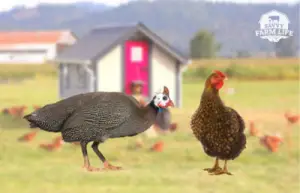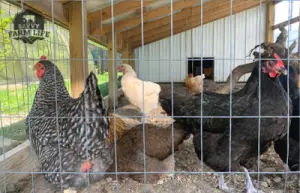The Difference Between Guinea Fowl & Chickens
Chickens have been a staple farm animal for both large and homestead farms for as long as anyone can remember. Their relatively low maintenance care needs combined with their egg and meat production potential make them a solid choice for most farmers. But what about guinea fowl? These African chicken-like birds have increased in popularity in the US over the last several years.
Guinea fowl look somewhat similar to chickens and can be raised to produce both meat and eggs, but what are the differences between guinea fowl and chickens? Guinea fowl and chickens differ in many ways, including behavior, habitat needs, vocalizations, and the taste of their meat and eggs. They also come from different continents, raise their hatchlings differently, and aren’t prone to the same diseases.
If you’re curious about adding one or both of these animals to your farm or homestead, read on for a full comparison of their various requirements and quirks.
Guinea Fowl & Chicken Appearance Differences 
While guinea fowl and chickens do appear to be similar types of birds, they have some distinct differences in appearance.
The most commonly found type of guinea fowl in the US farm trade is the helmeted guinea fowl. These animals typically have a bare, white or bluish head and throat, while chickens tend to have a full complement of feathers spreading over the darker skin of their head and neck. The guinea fowls’ “helmet” protrusion on top of their heads may or may not be accompanied by waddles under the chin. Guinea fowl also typically have a noticeably larger body-to-head ratio and weigh around 3 lbs as adults. Adult chickens tend to way in at around 1.5-2 lbs.
As for color variations, helmeted guinea fowl come in three basic color patterns: pearl, lavender, and white. The pearl morph is the most common. This is the dark background with little white dots or “pearls” sprinkled all over their feathers. The lavender morph is the same pattern as the pearl, but the background is a light shade of lavender instead of a dark coal color. And the white morph actually produces keets (guinea fowl chicks) with white feathers instead of yellow, and they remain white through adulthood.
Chickens come in a much more vast array of colors and patterns, including everything from white to black, solid to speckled or marbled, and oftentimes with some weird extra feathers making an artistic hairdo or foot-covering
Behavior Differences Of Guinea Fowl & Chicken
Guinea fowl are naturally more aggressive than chickens. They can be prone to bullying new flock members and are also more likely to fly the coop. Chickens tend to be better parents, more low-key flockmates, and uninterested in flying away. There are pros and cons to both of these species-specific tendencies.
Behavior Toward Each Other
Can chickens and guinea fowl be housed together? Yes, they absolutely can. And they make great roommates for each other, for the most part. However, they should not be confined together in a limited space for an extended period of time. Guinea fowl will grow restless and irritated if unable to roam free, and chickens are easy targets for pent-up energy in the larger birds.
While guinea fowl can be protective of their chicken friends, they need their space in order to do so. And chickens need space in order to escape more aggressive individuals when necessary. So while they can be housed together temporarily, it’s not a good idea to keep them confined together for too long. Out in the open, however, the two species get along very comfortably.
While guinea fowl can be the more difficult of the two to keep near home, the good news for them is that their keets, or hatchlings, are very impressionable. Guinea fowl raised by adult chickens usually pick up some of those milder characteristics and become more pleasant members of the farmyard to have around.
In fact, you may want to plan on having chickens raise your baby guineas anyway because guinea hens are terrible mothers. Not only will they roost in nonsensical places no matter how nice of a brooding area you provide, making eggs difficult to find, but they’ll also abandon the whole mothering endeavor once the eggs hatch.
Their offspring will want to follow them around, but the hen will be ready to be on her own again now that she doesn’t need to incubate the eggs. So the keets are at risk of being eaten, getting lost, and getting too cold from the moment they hatch.
You can solve this problem by removing the eggs (if you can find them) from the nest and placing them in an incubator, then fostering the keets with a broody hen who will mother them like her own the way they need to be mothered.
Behavior Differences Toward Predators 
While chickens are easy prey to coyotes, foxes, raccoons, and even birds of prey like hawks and eagles, guinea fowl are more of a challenge for these predators. They are extremely vocal when there are unwanted visitors in their territory and their calls can serve to scare off predators, alert chickens, and fellow guinea fowl to run for cover, and even let you know that there’s an uninvited guest in your yard that needs to be dealt with.
Guinea fowl calls are loud and can be annoying to neighbors, especially when they make a lot of noise over normal things like deliveries and a neighbor walking down the driveway to get the mail. But their help with predator alerts is a big advantage.
They are also more aggressive than chickens. Guinea fowl will often take on smaller predators rather than run away. This can be an advantage or a disadvantage depending on the circumstances.
Differences In Behavior Toward Environment
Chickens like sticking close to home and mostly on the ground. For guinea fowl, however, the world is a much larger, more three-dimensional place. They will roam far and wide, and not just on the ground. They love to roost in trees and explore higher-up places. Guinea fowl are so free-spirited, in fact, that it can take some training to get them to return home at night as your chickens do.
If you need to keep your flock contained, guinea fowl will make that a lot more challenging. While chickens can easily be kept in a confined area and will generally be content with it, guinea fowl are not so easily caged. You’ll need to cover the enclosure to prevent them from flying or climbing out.
Clipping their wings isn’t a permanent fix and will have to be redone often as their feathers grow back in. And it won’t stop them from climbing up fences. And once they know that letting a human close means being restrained and getting their wings clipped, good luck ever catching them again.
Additionally, while chickens are generally good healers from wounds, they are also susceptible to a lot of diseases. Guinea fowl tend to be a little healthier and hardier.
Due to their African origins, guinea fowl do not tolerate high humidity very well, especially as keets. They will struggle more than chickens in a humid environment and must always be provided with a clean, dry place to roost.
Guinea Fowl & Chicken Care and Maintenance Differences
Because of their unique personality tendencies, guinea fowl and chickens have different requirements for housing and diet.
Housing Differences 
Of the two species, chickens can live more comfortably in less space. Guinea fowl are louder and will be more likely to disturb neighbors living nearby. And due to their tendency to roam, if your property is on the smaller side, guinea fowl will be walking your neighbors’ property at some point in order to explore and forage. For limited space, chickens are typically a better option.
When it comes to introducing new members to the flock, guinea fowl also need to be introduced with a different method. In order to encourage them to view your home as their home, to which they should always return at the end of the day, you’ll need to take advantage of their need for a flock to feel safe.
When you first bring home new guinea fowl adults or when your hatchlings are large enough to release into the yard, do not release all of them at once. Keep them all penned in the yard where they can get used to the sights, sounds, and scents of your property without exploring off it. After a few weeks, release only one bird. While it will explore a little, it will want to be near the rest of its flock, so it will return to the pen area just to be near them.
After a couple of days of this, release another. As long as both of these are coming home as they should be, you can feel safe releasing the rest of the flock with the understanding that they will be back for shelter in the evening.
Whereas chickens, the more fearful, less adventurous of the two, are happy to put themselves up at night to stay safe from predators. They have a little more common sense in this one area to make up for their lack of bravery.
Chicken & Guinea Fowl Food Differences
Guinea fowl eat more bugs than chickens do. And they’re not afraid to take on larger prey such as mice and snakes when the situation arises. Because they are more carnivorously motivated than chickens, they’ll act as bug control for your garden without harming your plants. And thanks to their adventurous natures, they will go farther to forage. So you may not need to provide guinea fowl with as much feed as you would a flock of chickens. Especially in the warmer months.
When providing feed to guinea fowl with limited access to foraging opportunities due to confinement or the season, choose a higher protein feed than the typical chicken feed. Guinea fowl need more protein in their diets, which they usually forage for themselves when they have the opportunity. For flocks with plenty of foraging opportunities, allowing access to regular chicken feed is fine.
Otherwise, the dietary needs of the two species are fairly aligned. They require grit in their diet to help with digestion, just like chickens do. And they’ll also benefit from easy access to oyster shells.
Guinea Fowl And Chicken Taste Differences
Guinea fowl meat is similar to chicken, but a bit leaner, and therefore extra care must be taken to avoid overcooking it. It is a bit darker and more flavorful than chicken without being truly gamey. It pairs well with sweeter nuts, fruits, and root vegetables such as chestnuts, berries, and sweet potatoes.
Their eggs are also more flavorful, though as discussed, sometimes harder to find. The shells are thicker than a chicken egg as well and can be difficult to remove.
Can Guinea Fowl Mate with Chickens?
Yes, the two species can reproduce together. But it very rarely happens, and their offspring will be a bit odd-looking as well as sterile hybrids who cannot reproduce further.
Are Guinea Fowl or Chickens or Both Best for Your Farm?
If you have a more confined space, neighbors in close proximity, or are surrounded by busy roads, chickens will be a better choice for you than the adventurous, boisterous guinea fowl. But if you have more space and no one nearby who will be bothered by the noise, guinea fowl can make a great addition to your farm. They’ll eat the ticks, protect the chickens, and entertain you with their antics to no end.
Thank you for reading! Please save this article to your “Homestead” board on Pinterest using the button below!
